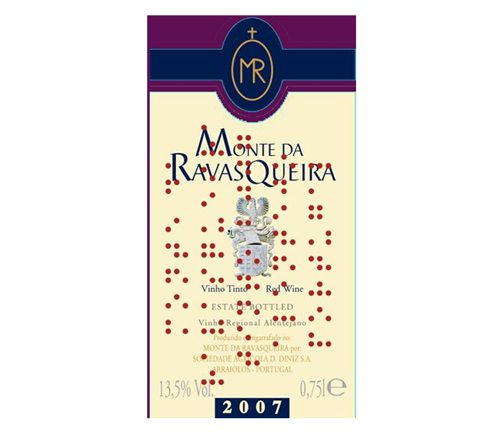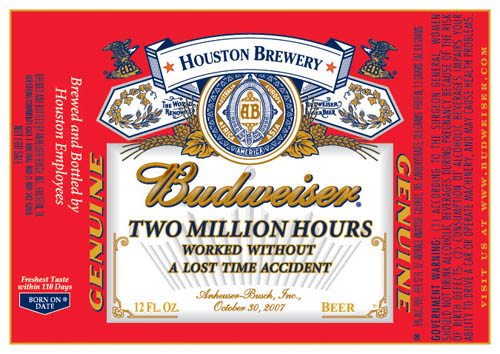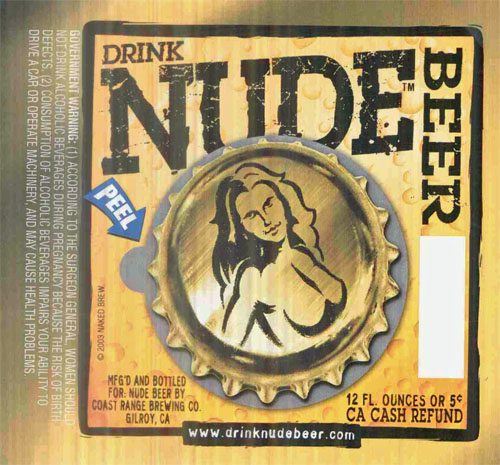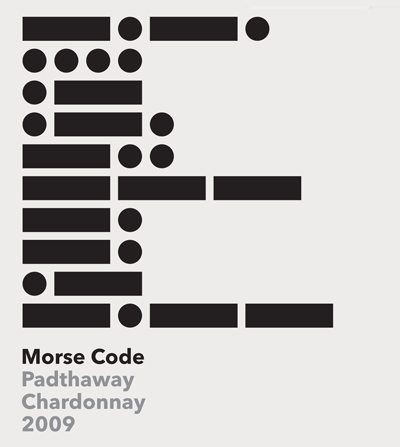This Bud label shows two million hours worked at the Houston brewery without a lost time accident.
Nude Beer
One might assume that beer + naked women is a nearly unstoppable combination. But it did not work out that way for Coast Range Brewing. It looks like the Gilroy, California purveyor of Nude Beer is long gone. Their last COLA was in 2006 and their last Nude Beer approval was in 2004. There is no sign of the company at the web address above. In all, the company got about 23 approvals for Nude Beer before fading away.
Coast Range provides a clear lesson that it takes a lot more than unclothed women to sell beer. In case it’s not obvious from the above image, the idea is that you buy the beer and then peel off part of the label to reveal a woman with little if any clothing. A slightly blurred example is at the end of this sentence but don’t click it if you don’t want to see nudity. This kind of stickering is a good option for companies that want to show something more than the government and retailers might otherwise allow. We wanted to capture it before it fades into ancient history. This also shows that the system has a lot of checks and balances, such as the market, and the government doesn’t need to carry the entire burden.
Too Remote Brewery

Perhaps it was too remote. Sadly, it closed a few months ago. The above is one of the last of about 12 approvals over just five months (for the most recent owner of the brewery). It’s a tough business and I suppose it’s even tougher when things like supplies and repairs and visitors are a few hours away. New West explains why the brewery could not carry on, complete with good photos. In the article, Lang’s marketing director confirms:
“The idea was great, the location was awesome — it’s such a gorgeous piece of property. … But business-wise it’s just hard to make a living when you don’t have consumers all around you.”
Was it really America’s most remote brewery? By what measure? What’s the most remote brewery now?
Cubes of Cachaca
Here is Leblon Cachaca Ice Cubes. It is Brazilian rum (with flavor), in a 200 ml. pack designed to freeze.
This should be of interest to Camper English at Alcademics, as he is inclined to tinker with all manner of alcohol beverages and ice.
The label says this product is “Made with Glazierepura Natural Freeze Technology.” BevNetwork explains that Glazierepura is a newly patented technology that can “freeze any alcohol and does not affect the flavor profile of the spirit.” Even though this Leblon product is only 40 proof, the technology would allow, for example, making ice cubes out of vodka — or even Single Malt Scotch. The US-Israeli company behind this technology partnered with Leblon for the offical US launch, on April 27, 2009 in New York.
Morse Code Labels
In the last post we discussed Braille wine labels. Today, Morse Code, as on this Australian wine label.
Morse Code was invented in the 1840s and is an early form of the digital encoding so widespread today. As with many of the Braille labels, the Morse Code label here does not seem to explain the message embedded in the code. Does TTB require it? Should TTB require it? Finally, who can decode this? For the energetic, there is a decoder here.
Braille Wine Labels

The technique is the same as printing visible labels: an iron Braille negative is pressed onto the back of the paper label to make the Braille bumps. Mr. Chapoutier decided to use his 40-year-old printing machine to make every one of the 2.5 million bottles of wine he produces each year. They have proved a success … . As fewer than 20,000 of the one million registered blind and partially sighted people in the UK can read Braille, other methods are also being urged including the use of audio-tapes, large print and computer disks.
The article explains that bleach and eye drops are the only other UK products imprinted with Braille.
It would seem that the Braille text should be covered on the TTB label approval, just like English letters, or any other language such as Japanese. And yet we have flipped through quite a few label approvals with Braille and very few mention Braille on the label approval.





